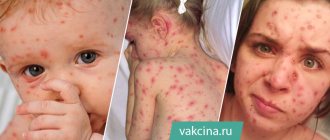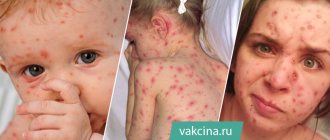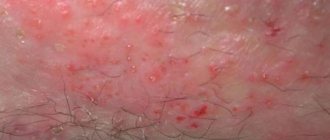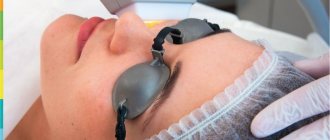Chickenpox - in common parlance, chickenpox is considered more a childhood than an adult disease, which you need to get over once and forget forever, as immunity to this disease is developed. Parents whose children have not yet been ill should be aware of this disease in order to provide the sick child with proper care.
The main sign by which chickenpox is recognized is blisters filled with clear liquid. The rash usually begins from the lower extremities, and within a few hours moves to the top of the head. Most often the disease is accompanied by high fever. It must be remembered that the bubbles that appear on the child’s skin should under no circumstances be squeezed out - scars may remain. Chickenpox is not always accompanied by large rashes; one patient may have from 10 to 50 abscesses, while another child may be covered with them from head to toe. The rash covers not only the skin, but can also form on the mucous membrane of the eyes, on the genitals and even in the mouth. The incubation period for chickenpox is 1 to 3 weeks and is transmitted by airborne droplets over a distance of up to 100 meters. This means that if your child, who was not sick, was in the same room with a chickenpox carrier, know that yours is next.
Chickenpox can be diagnosed by symptoms, without tests or examinations. A child with chickenpox needs home treatment. During the period of rashes, baths should be avoided. Nowadays, just like many decades ago, bubbles are smeared with brilliant green for the purpose of disinfection and drying. As a rule, children from 2 years old experience discomfort on the skin, accompanied by burning and itching. To alleviate the condition, the child is given allergy medications that help reduce itching. Make sure that the child does not scratch the abscesses, this will eliminate the possibility of infection under the skin. In some cases, when an infection occurs, children are prescribed an antibiotic that fights bacteria, but does not affect the course of chickenpox, since it is not effective for viral infections.
Prevention and treatment of chickenpox in children
In recent years, a vaccine has become available that prevents chickenpox infection. The vaccination is effective even after contact with a sick person, the main thing is to have it done within 72 hours. Children are vaccinated against chickenpox from 1 year of age. Immunity lasts for up to 20 years.
It is worth remembering that any disease must be diagnosed correctly and on time. Doctors at our clinic will help you understand the disease and prescribe effective treatment for chickenpox in children . You can make an appointment on this page.
Chickenpox - definition
Chickenpox (also known as varicella) is an infectious disease of Chickenpox (Varicella).
It is caused by the varicella zoster virus. By the way, a close relative of the herpes familiar to many. All herpes are contagious, but varicella is the coolest. Chickenpox spreads through airborne droplets, and does so very actively. To catch an infection, sometimes it’s enough to look into the patient’s room for a second.
It always seemed to people that the disease was literally carried through the air, by the wind. Hence the first part of the name - wind. It was named smallpox because of the numerous rashes in the form of fluid-filled vesicles (papules), similar to those that form in smallpox.
Fortunately, chickenpox is not as deadly.
Chickenpox symptoms
Chickenpox usually lasts about ten days. The main symptom of chickenpox is a typical rash. One to two days before the rash appears, the following nonspecific symptoms may occur:
- Fever
- Decreased appetite
- Headache
- Fatigue and general malaise
The chickenpox rash goes through three stages of development:
- Pink or red spots and bumps (papules), which appear in spurts, with each new wave of fever, 2-6 shocks per day, for 3-6 days.
- After a few hours, these papules turn into blisters filled with clear liquid (vesicles), they last for a day, after which they burst and the liquid flows out
- After the blisters burst, after a few hours weeping appears - in their place crusts form, which last from several days to several weeks until new tender skin forms under them, after which they fall off.
Causes and features of pathogen transmission
The disease spreads quickly and easily indoors, since the causative agent, the herpes virus, can be transmitted through coughing, sneezing, i.e. by air. A greater number of chickenpox cases occur in preschool children. Children staying in the same group room of a kindergarten get sick faster, although the virus is able to penetrate with air flow into neighboring rooms. Less commonly, the pathogen is transmitted through toys or third parties, since it is unstable in the external environment.
The peak of the disease occurs in spring/autumn, together with the peak of colds. The pathogen is transmitted by the bloodstream to the epithelial layers of the skin, where it begins to actively multiply. There are subjective signs of the onset of the disease: irritability, tearfulness of the child, the appearance of a common rash similar to hives. Due to the mobility of the virus in the blood, internal organs may be affected. The mucous membrane is an excellent “soil” for the virus; as a result, small hemorrhages form at the site of the papules. Immunity after the disease is stable (except for early infection by the virus).
Adults who did not have chickenpox as children may not get sick at all if they have a strong immune system. But when infected, adults become seriously ill, with a high rise in body temperature, and subsequently scars and visible dents form in place of the papules.
Features of the pathogen:
- papular fluid contains DNA;
- the virus is deactivated at a temperature of 45 to 50 degrees. It is enough to soak the patient’s clothes in hot water for half an hour to destroy the virus. Disinfectants should not be used when processing children's clothing; they can cause increased itching and rashes;
- the virus is not destroyed by freezing; after defrosting, the pathogen is still active. But it does not tolerate sunlight well, so when disinfecting a room, you can use ultraviolet lamps;
- the pathogen can be transmitted through the placenta from a sick pregnant woman to the fetus, as a result of which there may be damage to the fetus that does not threaten its life;
- in exceptional cases, chickenpox is contracted twice, if the first time occurred before the age of one year, when the child’s own immunity is not yet “working.”
Symptoms of the disease
On average, up to two weeks after the virus enters the body, the child feels normal. Then the body temperature rises sharply and quickly, and at the same time rashes appear on the head under the hair, cheeks, near the lips, and on the mucous membranes of the mouth. Due to the rash, the child becomes restless, the unpleasant tingling sensations in the papules a little later turn into severe itching, and the baby’s condition worsens.
Development of chickenpox
Initially, only a rash is visible on the skin, similar in appearance to miliaria. Then characteristic small spots become visible, in place of which bubbles with transparent contents - vesicles - form. There is always a small border around the bubble - a hyperemic halo. After a few hours, the liquid in the bubble becomes cloudy, and even later the bubble bursts and the liquid begins to flow out of it. If the vesicle is not touched, then after two or three days it begins to dry out. A dense crust forms from the center to the edges of the bubble, and after the crust has completely dried, the skin remains pink, but without scars, smooth to the touch. If a child actively scratches the rash, indentations may form, as after a BCG vaccination.
The bubbles do not appear all at once, but several days apart, so quarantine for chickenpox lasts up to three weeks. During this time, rashes in different stages of development may be visible on the skin - from spots to crusts. To treat chickenpox, doctors still recommend using a solution of brilliant green, which disinfects and dries watery blisters. Yes, it is ugly, the child will walk around with spots, but it is effective in preventing suppuration from scratching and the rapid healing of wounds.
If the course of the disease is severe, with a large amount of rash, the child is prescribed medications that lower the temperature and antihistamines. Acyclovir is effective only if used in a timely manner; if the disease is protracted, it should not be used. Sometimes doctors prescribe immunostimulants, for example, cycloferon liniment - it successfully replaces brilliant green. The drug facilitates the course of the disease and prevents the development of purulent infection when the blisters are scratched.
Chickenpox: course of the disease
Chickenpox is characterized by stages, which allows you to assess the course of the disease and navigate the quarantine period.
The incubation period of chickenpox is the time that elapses between the virus entering the body and the appearance of the first symptoms of the disease. It usually lasts 2 weeks, but can range from 10 to 21 days. The incubation period for chickenpox in adults and children is usually the same length.
The prodromal period is the initial stage of chickenpox. It is short (1-2 days), and may be absent altogether. Its characteristic symptoms are poor health, fever, muscle and headaches, and catarrhal phenomena in the nasopharynx. The first symptoms of chickenpox in adults are usually more pronounced than in children.
The rash period lasts 3-10 days. Elements of the rash appear in waves, this is accompanied by an increase in body temperature and poor health. 1-2 days pass between “waves” of rashes. There are usually 2-5 of these “waves”, then new elements stop appearing and gradually heal. The next stage begins - healing.
The recovery period begins from the moment when new elements cease to form, and all that appear become covered with crusts.
The period of convalescence (recovery) after chickenpox can last up to 1 year. The varicella-zoster virus causes a serious blow to the human immune system, and the process of its recovery is usually quite long. During this period, the body's resistance to other viral infections, such as ARVI, decreases.
How many days chickenpox lasts depends on the individual characteristics of the disease, the patient’s age, and the state of his immunity. On average, from the moment the first signs of chickenpox appear in a child until the elements of the rash completely heal, 3 weeks pass; in adults it may be longer.
Treatment
If pathology is diagnosed, then treatment of chickenpox in children should be symptomatic. Young patients are given antipyretics if the temperature exceeds 38.5. Medicines that reduce itching are also prescribed, for example, antihistamines such as diazolin, suprastin and some others (as prescribed by a doctor).
In addition, the blisters are lubricated with a solution of brilliant green, due to which they dry out, itch less and heal faster. It would be correct to use drugs that enhance immunity to treat chickenpox. But in adult patients, chickenpox, a type of herpes virus, is treated with Acyclovir.
Types of chickenpox (classification of chickenpox).
Chicken pox occurs in typical and atypical forms and in terms of severity is mild, moderate and severe. Chickenpox is also classified according to ICD-10 (with meningitis, encephalitis, pneumonia).
Atypical forms of chickenpox are divided into:
- Hemorrhagic form - a common consequence of this form is bleeding, and this form occurs in people with thrombocytopenia.
- Pustular form - develops when a bacterial agent is attached.
- Gangrenous form - can lead to the development of sepsis and occurs most often in patients with weakened immunity.
- The generalized (visceral) form of chickenpox is characterized by development in patients with immunodeficiency. It is very difficult, the symptoms are more pronounced and often ends in death for the sick person.
- The rudimentary form is found in children who received immunoglobulin during the incubation period. It flows quite easily.
The severity of chickenpox is directly determined by the degree of intoxication syndrome and its criteria, as well as the presence of specific vesicular rashes on the skin and mucous membranes. It should be noted that there are also so-called abortive (very mild) cases of the disease, which occur without the appearance of fever and are characterized by the appearance of single rashes on the skin of the abdomen and back. Such chickenpox is detected in kindergarten during examinations during outbreaks.
To the question “how long does chickenpox last?” It is difficult to answer unequivocally, since the duration of the disease directly depends on the form and course of chickenpox. On average, in the classical (typical) course, the duration of the disease is from 12 to 16 days.
Complications
Despite the fact that until recently this disease was considered mild, the consequences of chickenpox in adults can be quite serious. If the rash has spread to the mucous membranes, in the future (with weakened immunity) it may appear on the internal organs. The peculiarity of the mucous membranes is that it is difficult for rashes to dry out on them - they turn into erosions and take much longer to heal. Erosions on internal organs bleed, which can lead to the development of internal bleeding. In some cases (with liver damage), areas of necrosis may form.
In the absence of proper skin care, when bacteria enter the area of scratching, as well as when the function of the immune system is significantly weakened, suppuration may occur on the skin. Inflammatory diseases of internal organs may also develop: pneumonia, hepatitis, nephritis, encephalitis, meningitis, endocarditis, and others. The most common cases are pneumonia and damage to the nervous system, which are quite severe against the background of chickenpox. The mortality rate for the development of chickenpox encephalitis can reach 20%.
Diagnosis of chickenpox
The basis for detecting herpes is a virological study - examination of media to detect the pathogen. In case of chickenpox, for diagnosis, liquid from vesicles is used, in which, when stained, accumulations of the pathogen, the Argan corpuscle, are isolated.
Chickenpox is usually distinguished from insect bites. The main difference is the lack of development of elements and bedding, as well as normal body temperature.
Also, the disease should be differentiated from:
- streptoderma - occurs without fever, the rash is different - cloudy, purulent contents, after involution leaving a yellow crust, in its place a red spot forms. The rash is located mainly behind the ears and on the extremities, never on the scalp (a hallmark of chickenpox).
- herpes zoster - the blisters are located strictly along the nerve trunk; they practically never occur on the legs and arms.
- vesicular rickettsiosis - a small scab forms at the site of the tick bite, followed by the formation of an ulcer (a scar forms in its place after healing). Enlargement of regional lymph nodes is typical.
Forms and stages of the disease
The disease occurs with or without obvious symptoms. Dermatologists identify several characteristic forms of chickenpox:
| Light | the rash is not abundant, the condition is satisfactory, there are no secondary rashes, there are no enanthems. |
| Medium-heavy | Intoxication, weakness, and headaches were noted. Repeated rashes are observed, the period is up to five days. A specific rash is noticeable, enanthems are detected. The temperature reaches 39 degrees. |
| Heavy | pronounced intoxication, high temperature (up to 40 degrees). Numerous blisters cover the entire body, including the scalp and genitals. There is a high risk of damage to internal organs. Often the picture is complicated by a pyogenic infection. |
The hidden or atypical form has several varieties. All of them are dangerous with serious complications:
| Generalized | noted in patients receiving chemotherapy and people with reduced immunity. Internal organs, the nervous system, are affected, the brain is affected, and chickenpox pneumonia develops; |
| Hemorrhagic | difficult to treat, the prognosis for a weakened immune system is extremely unfavorable; |
| Gangrenous | the variety is characterized by the addition of pathogenic microflora, severe poisoning of the body, necrosis of certain areas of the skin, and poor health. |
When to see a doctor?
If you suspect that you or your child has chickenpox, consult your doctor. The doctor will be able to make a diagnosis simply by examining you, studying the elements of the rash and accompanying symptoms. Your doctor may also prescribe medications to reduce the severity of chickenpox and reduce the risk of complications, if necessary. Call the pediatrician in advance and warn that you suspect chickenpox - the doctor will see you in a separate room, without waiting in line, to avoid the risk of infecting other patients.
Also, be sure to tell your doctor if you have any of these complications:
- The rash has spread to one or both eyes.
- The skin around some parts of the rash becomes very red, hot, or painful, indicating a secondary bacterial skin infection.
- The rash is accompanied by dizziness, disorientation, rapid heartbeat, shortness of breath, tremors (shaking hands), loss of muscle coordination, increasing cough, vomiting, difficulty bending the head forward, or a fever above 39.4 C.
- a history of any immunodeficiency, or age younger than 6 months.
Types of rashes and localization
If you are in doubt what type of rash you have on your skin and you don’t know how to determine whether you have chickenpox or an allergy, consult a doctor who will help determine what kind of illness you have. The rash caused by chickenpox and allergies have certain differences. Let's look at them in more detail:
Chickenpox rash
It is usually not difficult for parents to recognize chickenpox in a child. Chickenpox rashes appear on the scalp or abdomen and gradually spread throughout the body.
Chickenpox pockmarks appear in waves. During each wave, a child or an adult experiences an increase in temperature. Rashes of all three stages can be observed on the body.
It is strictly forbidden to scratch pockmarks with chickenpox, because this increases the risk of infection and can leave scars on the skin. Antihistamines cannot have a visible effect on chickenpox rash, but they can dull the itching a little.
Allergy rash
Allergy rashes are local in nature. They are usually grouped in a certain area and tightly.
Allergic rashes look the same and occur, mainly, simultaneously forming spots with redness.
With an allergic reaction, the rashes look the same and all appear at the same time.
If you take antihistamines and follow a hypoallergenic diet (if necessary), the rashes will go away and the skin will recover after them.
Table: Difference between chickenpox rash and allergy rash
How to treat chickenpox
Chickenpox is a virus. And, like most viruses, there is no specific treatment for it. Helping a sick person comes down to alleviating the main symptoms.
Fever and headache
Remember: paracetamol and nothing else! Popular painkillers and antipyretics based on ibuprofen should not be taken. The use of nonsteroidal anti-inflammatory drugs and the risk of serious skin and soft tissue complications in patients with chickenpox or herpes zoster have been reported to indicate that ibuprofen for chickenpox increases the incidence of complications such as skin infections.
Aspirin is completely contraindicated. In conjunction with the varicella-zoster virus, it has a powerful toxic effect on the liver and brain (the so-called Reye's syndrome).
Itching
To relieve itching, your doctor may recommend an antihistamine. Considering the insidiousness of the virus, under no circumstances prescribe it to yourself!
You can also treat your skin with calamine lotion according to the instructions.
Scratches and wounds
To avoid scratching the skin and causing infection in the wounds:
- Trim your nails as short as possible. If your baby is sick, put on thin protective gloves.
- Wear clean, loose clothing.
- Change your underwear and bed linen more often.
It is not necessary to smear the rashes with brilliant green: brilliant green will not speed up the maturation of the blisters. The color only helps to mark pimples in order to track the moment when new ones stop appearing.
Soreness in the mouth
If there are rashes on the oral mucosa, doctors recommend eating sugar-free popsicles. The cold will help relieve discomfort. Also try not to eat salty and spicy foods.
What to do if scars appear after chickenpox?
There are various options to solve this problem:
- Ointments and gels for the treatment of scars. A small amount of gel is rubbed into the scar 2-3 times a day. For old scars, apply the gel under the bandage at night. The course of treatment can take from 1 month to a year. For treatment the following are used: Contractubex; Aldara; Dermatix; Kelofibrase; Skarguard.
- Chemical peeling using phenol. Under the influence of aggressive chemicals, the keratinized layer of the epidermis and dermis is removed. After the epidermis is restored (takes up to 2 weeks), the skin becomes smooth.
- Injection of collagen under the skin. The substance fills the skin defect and stimulates the formation of connective fibers.
- Microdermabrasion is the mechanical polishing of the skin with particles of a solid substance (diamond). As a result of microtraumas, collagen production is activated. The procedure allows you to even out the skin texture and make scars less noticeable.
- Laser skin resurfacing. A focused laser beam penetrates the superficial layers of the dermis and heats them, evaporating the water. After the regeneration of skin cells, its surface is leveled. Caution: Carbon dioxide laser treatment may cause the appearance of a hypertrophic keloid scar that rises above the skin. Therefore, an erbium or carbon dioxide laser is used.
Before use, you should consult a specialist.
What complications can occur with chickenpox?
The disease is usually mild, but complications may occur, including bacterial infections (eg, bacterial skin lesions, pneumonia) and neurological infections (eg, encephalitis, meningitis, myelitis), which can be fatal.
Secondary bacterial skin infections, which are caused by streptococcus or staphylococcus, are the most common cause of hospitalization and outpatient medical visits. Secondary infection with invasive group A streptococci can cause abscesses and cellulitis.
Pneumonia after chickenpox is usually viral, but can also be bacterial. Secondary bacterial pneumonia is more common in children under 1 year of age. It is characterized by an increase in temperature up to 40⁰C, an increase in pallor and cyanosis of the skin, the appearance of a substernal dry cough and shortness of breath. Patients can take a forced position in bed.
Damage to the central nervous system in chickenpox ranges from aseptic meningitis to encephalitis. Cerebellar involvement followed by cerebellar ataxia is the most common presentation of central nervous system disorders but usually has a positive outcome.
Encephalitis is one of the most dangerous complications of chickenpox (10-20% of cases are fatal). This complication manifests itself as headache, nausea, vomiting, convulsions and often leads to coma. Diffuse brain involvement is more common in adults than in children. Chickenpox meningitis may occur together with encephalitis or independently.
Rare complications of chickenpox include Guillain-Barré syndrome, thrombocytopenia, hemorrhagic and bullous chickenpox, glomerulonephritis, myocarditis, arthritis, orchitis, uveitis, iritis and hepatitis.
Once infected, the virus remains hidden in nerve cells and can be reactivated, causing a secondary infection, herpes zoster. It usually occurs in adults over the age of 50 or with a weakened immune system and is associated with a painful rash that can cause permanent nerve damage.
Features in pregnant women
Complications after chickenpox in adults frighten people who have not yet had time to recover from this disease. But pregnant women worry much more about this, fearing for the life of their unborn baby.
Unfortunately, the herpes virus ||| type has a strong damaging effect on the fetus. If a woman gets chickenpox in the first trimester, it most often leads to a miscarriage. In the second trimester, the fetus may develop malformations, defects of organs and systems, and after birth - developmental delays. If the expectant mother suffered the disease in the third trimester, this poses the least danger to the baby. But in rare cases, a newborn may develop congenital chickenpox, which can be fatal.
Therefore, it is important for pregnant women to undergo a blood test in a timely manner, which will show the presence of antibodies to particularly dangerous infections, and also to protect themselves and their unborn baby throughout the entire period of gestation.
Chickenpox and pregnancy
A special type of complications from chickenpox can occur in pregnant women. Chickenpox in early pregnancy can lead to a variety of problems in the newborn, including low birth weight and birth defects such as limb abnormalities. A particularly great threat to the child occurs when the mother gets chickenpox a week before giving birth. In this situation, there is a high risk of infection that is life-threatening to the newborn (congenital chickenpox syndrome).
If you are pregnant and have been in contact with someone who has chickenpox, be sure to talk to your doctor about the risks to you and your unborn baby.
Chickenpox incubation period in adults
This period of time is characterized by the absence of any symptoms and lasts from the moment of infection until the first signs of intoxication appear.
The classic development of the clinical picture suggests that the incubation period lasts approximately 2 weeks, however, the older a person becomes, the longer it takes from infection to the first symptoms. In an adult, it is considered normal if the temperature rises three weeks after contact with an infected person.
Is it possible to wash yourself if you have chickenpox?
“Is it possible to swim if you have chickenpox?” is an age-old question parents ask their pediatrician. The answer depends on the patient’s well-being. In general, bathing with chickenpox is not only safe, but even beneficial - keeping the skin clean reduces the risk of secondary infection and promotes faster healing. However, at high body temperatures, it is better to refrain from water treatments and limit yourself to treating the rash elements with antiseptics.
If you have chickenpox, you can bathe in a weak solution of potassium permanganate or with herbal decoctions, but it is better to refrain from using cosmetics (shower gels and even soap). It is also undesirable to use washcloths and towels, as they can injure the skin.
Allergy or chickenpox - what's the difference?
For chickenpox to occur, it is necessary for a specific pathogen to penetrate the body - a virus that has an incomparable protein structure.
Herpes virus under a microscope
The allergic process is provoked by substances belonging to different classes of chemical compounds. These are not only proteins alien to the body (food or otherwise), but also substances of simple chemical composition (the class of fruit sugars), or even inorganic compounds, such as soot or ordinary sand - the main components of any dust.
Allergies are caused by allergens, most often food
The time for chickenpox rash to appear on the body is the period required for the virus to begin to multiply massively (about 14 days from the moment of infection). An allergic rash appears a few minutes (tens of minutes) after the substance penetrates the human body.
For the virus to exist, it must penetrate the respiratory tract - an allergy begins both when an allergen substance is inhaled, and when it comes into contact with the skin (by spraying) or into the skin (by injection by insects or other means).
If the occurrence of an allergic response is a reaction caused by the genetic structure of the body, then the development of chickenpox does not depend on the genetic characteristics of a person - susceptibility to the virus is close to 100%.










